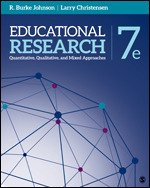Educational Research
Quantitative, Qualitative, and Mixed Approaches
- R. Burke Johnson - University of South Alabama, USA
- Larry Christensen - University of South Alabama, USA
FREE DIGITAL TOOLS INCLUDED WITH THIS TEXT
SAGE edge gives instructors and students the edge they need to succeed with an array of teaching and learning tools in one easy-to-navigate website. Learn more: edge.sagepub.com/rbjohnson7e
Supplements
SAGE edge for instructors supports your teaching by making it easy to integrate quality content and create a rich learning environment for students with:
- a password-protected site for complete and protected access to all text-specific instructor resources;
- a test bank that offers a large and diverse set of test questions and answers for each chapter of the book. Multiple-choice and true/false questions are included for every chapter to help you assess students’ progress and understanding;
- editable, chapter-specific PowerPoint® slides that assist with lecture and review, highlighting essential content, features, and artwork from the book;
- carefully selected, and updated web-based video resources featuring relevant content for use in independent and classroom-based exploration of key topics;
- teaching tips designed to help conceptualize your overall teaching plan for each chapter;
- lecture notes that summarize key concepts by chapter to help prepare for lectures and class discussions;
- lively and stimulating ideas for class activities in and out of the classroom to reinforce active learning;
- datasets and SPSS exercises for additional hands-on practice;
- exclusive access to multiple full-length SAGE journal articles, providing examples and discussion of ideas explained in the book;
- downloadable versions of the tables, figures, and worksheets;
- suggested answers to the review questions found throughout each chapter (provided by the author); and
- sample syllabi for quarter, semester, and online courses.
SAGE edge for students enhances learning, it’s easy to use, and offers:
- an open-access site that makes it easy for students to maximize their study time, anywhere, anytime;
- eQuizzes that allow students to practice and assess how much they’ve learned and where they need to focus their attention;
- suggested answers to review questions to help students study and master the chapter material;
- concept maps to show students links among the concepts and see the “big picture”;
- lecture notes for students to review and bring to class;
- eFlashcards that reinforce student understanding and learning of the key terms and concepts outlined in the chapters;
- carefully selected, web-based video links featuring relevant content for use in independent and classroom-based exploration of key topics; and
- exclusive access to multiple full-length SAGE journal articles, providing examples and discussion of ideas explained in the book.
“The innovative structure of Educational Research paves the way for students to build a cohesive understanding of the research process and learn to appreciate various approaches to research design without positioning any one paradigm as the ‘default.’”
“Educational Research provides students the introduction that is needed for them to be both consumers and producers of educational research.”
“Educational Research is an excellent textbook that meets the needs for a course based on CACREP standards. Extremely reader friendly with helpful supplemental materials.”
“Educational Research contains invaluable wisdom and advice from leading scholars. It is accessible to a wide audience, including management scholars, undergraduate and graduate students majoring in business, and working professionals in the field of management and marketing. I greatly admire this textbook.”
Very comprehensive, nice background reading for any scholar conducting educational studies.
This text provides a comprehensive introduction to research: qualitative, quantitative, and mixed methods are all covered well to provide a basic understanding in preparation for more advanced research methods courses.




